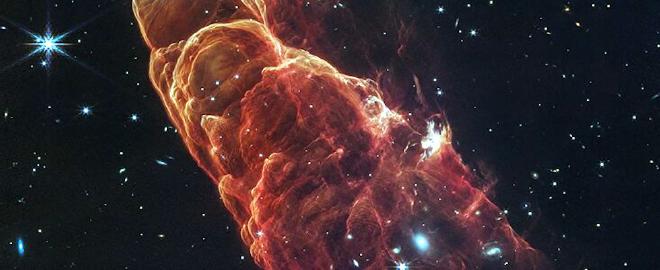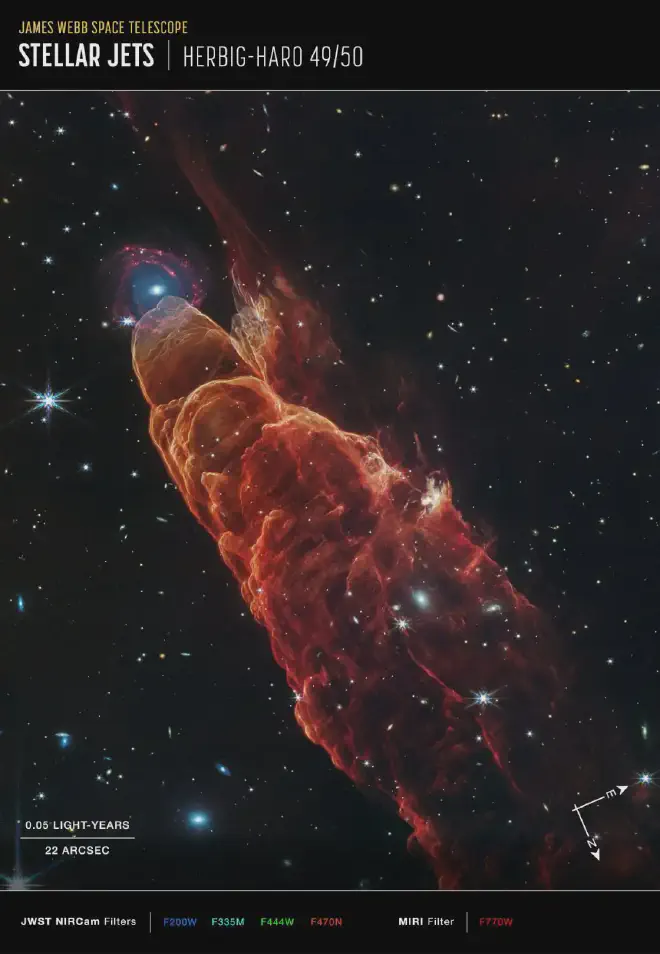

James Webb Space Telescope has captured a beautiful juxtaposition of the nearby protostellar outflow known as Herbig-Haro 49/50 with a perfectly positioned, more distant spiral galaxy. Due to the close proximity of this Herbig-Haro object to the Earth, this new composite infrared image of the outflow from a young star allows researchers to examine details on small spatial scales like never before. With Webb, we can better understand how the jet activity associated with the formation of young stars can affect their surrounding environment.
This new composite image combines observations from Webb’s NIRCam (Near-Infrared Camera) and MIRI (Mid-Infrared Instrument), which provides a high-resolution view to explore the exquisite details of this bubbling activity. Herbig-Haro 49/50 is located about 630 light-years from Earth in the constellation Chamaeleon.
Herbig-Haro objects are outflows produced by jets launched from a nearby, forming star. The outflows, which can extend for light-years, plow into a denser region of material. This creates shock waves, heating the material to higher temperatures. The material then cools by emitting light at visible and infrared wavelengths.

When NASA’s Spitzer Space Telescope observed it in 2006, scientists nicknamed Herbig-Haro 49/50 (HH 49/50) the “Cosmic Tornado” for its helical appearance, but they were uncertain about the nature of the fuzzy object at the tip of the “tornado.” With its higher imaging resolution, Webb provides a different visual impression of HH 49/50 by revealing fine features of the shocked regions in the outflow, uncovering the fuzzy object to be a distant spiral galaxy, and displaying a sea of distant background galaxies.
HH 49/50 is located in the Chamaeleon I Cloud complex, one of the nearest active star formation regions in our Milky Way, which is creating numerous low-mass stars similar to our Sun. This cloud complex is likely similar to the environment that our Sun formed in. Past observations of this region show that the HH 49/50 outflow is moving away from us at speeds of 100-300 kilometres per second and is just one feature of a larger outflow.
This video provides special data visualisation of Herbig-Haro 49/50, as seen by the NASA/ESA/CSA James Webb Space Telescope. This is an outflow from a nearby still-forming star, in high-resolution near- and mid-infrared light with the NIRCam and MIRI instruments. The intricate features of the outflow, represented in reddish-orange color, provide detailed clues about how young stars form and how their jet activity affects the environment around them. A chance alignment in this direction of the sky provides a beautiful juxtaposition of this nearby Herbig-Haro object (located within our Milky Way) with a more distant, face-on spiral galaxy in the background. Credit: NASA, ESA, CSA, STScI, J. DePasquale, L.Hustak, G. Bacon, R. Crawford, D. Kirshenblat, C. Nieves, Alyssa Pagan , F. Summers
Webb’s NIRCam and MIRI observations of HH 49/50 trace the location of glowing hydrogen molecules, carbon monoxide molecules, and energised grains of dust, represented in orange and red, as the protostellar jet slams into the region. Webb’s observations probe details on small spatial scales that will help astronomers to model the properties of the jet and understand how it is affecting the surrounding material.
The arc-shaped features in HH 49/50, similar to a water wake created by a speeding boat, point back to the source of this outflow. Based on past observations, scientists suspect that a protostar known as Cederblad 110 IRS4 is a plausible driver of the jet activity. Located roughly 1.5 light-years away from HH 49/50 (off the lower right corner of the Webb image), CED 110 IRS4 is a Class I protostar. Class I protostars are young objects (tens of thousands to a million years old) in the prime time of gaining mass. They usually have a discernible disk of material surrounding it that is still falling onto the protostar. Scientists recently used Webb’s NIRCam and MIRI observations to study this protostar and obtain an inventory of the icy composition of its environment.
https://youtu.be/wx5wz1HbUuA
This Space Sparks episode features a new image from the NASA/ESA/CSA James Webb Space of Herbig-Haro 49/50 and a perfectly positioned, more distant spiral galaxy. Credit: Directed by: Bethany Downer and Nico Bartmann. Editing: Nico Bartmann. Web and technical support: Enciso Systems. Written by: Bethany Downer. Music: Stellardrone - The Belt of Orion. Footage: NASA, ESA, CSA, STScI, J. DePasquale, L.Hustak, G. Bacon, R. Crawford, D. Kirshenblat, C. Nieves, Alyssa Pagan , F. Summers, N. Bartmann (ESA/Webb)
These detailed Webb images of the arcs in HH 49/50 can more precisely pinpoint the direction to the jet source, but not every arc points back in the same direction. For example, there is an interesting outcrop feature (at the top right of the main outflow) which could be another chance superposition of a different outflow, related to the slow precession of the intermittent jet source. Alternatively, this feature could be a result of the main outflow breaking apart.
This video takes the viewer on a journey to Herbig-Haro 49/50, an outflow from a nearby still-forming star, in high-resolution near- and mid-infrared light with the NIRCam and MIRI instruments. The intricate features of the outflow, represented in reddish-orange color, provide detailed clues about how young stars form and how their jet activity affects the environment around them. A chance alignment in this direction of the sky provides a beautiful juxtaposition of this nearby Herbig-Haro object (located within our Milky Way) with a more distant, face-on spiral galaxy in the background. Credit: NASA, ESA, CSA, STScI, ESO, Digitized Sky Survey 2, unWISE, JPL-Caltech, N. Bartmann (ESA/Webb), E. Slawik, N. Risinger, D. De Martin, D. Lang (Perimeter Institute), M. Zamani (ESA/Webb) Music:Tonelabs – The Red North (www.tonelabs.com)
The galaxy that appears by happenstance at the tip of HH 49/50 is a much more distant, face-on spiral galaxy. It has a prominent central bulge represented in blue that shows the location of older stars. The bulge also shows hints of “side lobes” suggesting that this could be a barred-spiral galaxy. Reddish clumps within the spiral arms show the locations of warm dust and groups of forming stars. The galaxy even displays evacuated bubbles in these dusty regions, similar to nearby galaxies observed by Webb as part of the PHANGS program.
- The article Webb unmasks true nature of the Cosmic Tornado was published in Esa’s Webb website

